MyHimalayasimpressions from |
|
|||||||
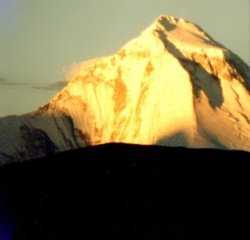
Chorten at the entrance of Tetang, the village itself lies further up on a little plateau.
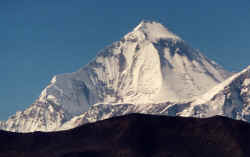
Dhaulagiri from the pass between Tetang and Muktinath
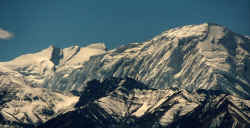
The summit of Annapurna I in the left is the highest point of the Annapurna
range, but the steep ice flanks of Tilicho are not any less impressive.
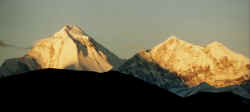
The early catches the worm, getting up early is often rewarded in the Himalayas.
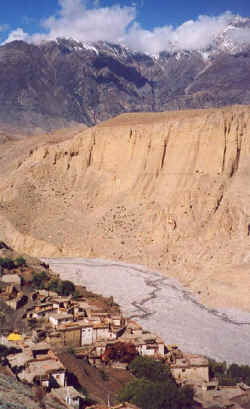
Detour to Lubra is worth it, the mountain views and friendly people are great.

Stunning Annapurna range, a view that opened up unexpectedly while walking
from Muktinath to Lubra. Finding the way was difficult, we didn't meet anyone
while on the main route along the Kali Gandaki dozens of tourists and Indian
pilgrims were on their way to or from the holy site of Muktinath.
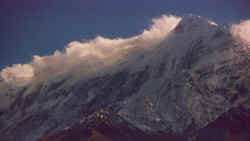
Nilgiri in the morning, just before flying back to Pokhara.
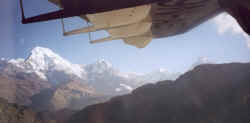
Annapurna Fang (though I am not sure) and Machapuchare are getting smaller while
the green terraces become more numerous.
Upper Mustang: Tetang - Muktinath - Jomosom
Tetang - Muktinath - Jomosom
Tetang - Muktinath
I was almost too hot in my sleeping back, and the howling jackals were bothering, too, but after all I slept as well as always. We heard the sound of something heavy falling down last night at dinner and thought of rocks. Tenzing tells us now that it was the donkey of a group coming from Tangye. It's a 10-hour march to there and the group arrived before dusk, their pack horses got here even later. One missed the trail and fell down the cliff in the night.
We have to reach Muktinath today because our 10-day visa runs out and we need to get to the checkpoint today. After an early start we have a nice view over the town and the Kali Gandaki. Tethang seems to consist of two villages with high walls around them, from a distance they look like big forts. Maybe I should have spent some time in the village yesterday, it could have been very interesting.
The ascend to a plateau is steep and the way hard to find. The easy walk over the plain is short, from then on it's another three hours of hard walking steeply uphill. At times the narrow path goes over loose black gravel along an precipitous hillside, but most of the time it is 'only' steep. After climbing up high in the valley the trail makes a right turn and way up I can see the pass. The trail seems endless, high above the kitchen boys are taking a short break, far down is the rest of the group. A few yaks and horses graze here, but apart from that I don't meet any living being.
Finally I reach the pass, the mountains are amazingly close! Thorung Peak is the most impressive peak although it is the 'lowest' one. Big glaciers cling to its steep flanks, it looks as if they crashed down any minute. Tilicho is completely snow-covered with indented glaciers, the top of Annapurna further behind doesn't seem as high as 8'000 metres. Even the north face of Nilgiri has glaciers coming down the almost vertical rock face.
It is a moderate walk downhill to Muktinath, and here I feel for the first time that the trek is coming to na its end. I've been in this area before and know that the excitement, beauty and adventure of Mustang are over now. Nevertheless, I enjoy the stunning view of Dhaulagiri (8'167 m) and the Annapurna massif (8'091 m). Both summits are only 34 km apart, making the Kali Gandaki valley the deepest gorge on earth. Muktinath seems close now, but getting there involves crossing another valley which takes some time. While waiting for the others we notice the huge numbers of fossils which just lie around. This keeps us busy for awhile, looking for them on the dusty way from Chusang to Chele and collecting even the smallest ones seems like a bad joke now.
Although it's only 300 in the afternoon the light makes it look like a lovely autumn evening in Switzerland. The yellow leaves that fall from the trees intensify this impression. It is quiet and peaceful, the atmosphere almost drowsy. We stroll through sporadic houses which become more numerous the closer we get to the religious place. Muktinath is considered to be very holy by both Hindus and Buddhists. It's a small village but the souvenir shops, guesthouses, restaurants and number of people are enough for a minor culture shock. I prefer getting used to 'normal' life slowly, instead of joining the others who go for coffee and cake I enjoy Nima’s and Sabita’s company and try to remember and memorise the great time I had in the Lost Tibetan Kingdom.
After two weeks of getting up early we can sleep in. After breakfast we visit the temple district of Muktinath which is a few minutes above town. Sabita and Nima went the puja earlier and have come back with bottles of holy water. They are leaving for Jomosom today in hope to get a seat on tomorrow’s flight to Pokhara. Our liaison officer has taken the opportunity to hold an official good-bye speech, maybe he is not such a bad person after all
108 sources spring here, taking a bath in that water is considered to bring good luck. Many people collect the water in bottles to bring it home to their family and relatives. The other holy sign is a natural flame that comes out of a rock. Built around it is a Buddhist temple, the paintings and statues are nice but it is annoying when a crazy old woman is watching and yelling at you if you don't give a donation. I'm totally fine with supporting education, maintenance and restoration of monasteries but Muktinath seems to be misused as a cashcow.
Buddhists and Hindus alike go on a pilgrimage to here. Partly due to the fact that there are more tourists than locals the atmosphere is not very solemn. But even four years earlier when it was crowded with Hindu pilgrims it wasn't very impressive.
I don't do much else today, the original plan was to climb a nearby 5'000 peak but we get rid of that idea. Somehow it feels good to rest after two weeks of walking.
Muktinath - Lubra - Jomosom
This feels like the coldest morning on the trek, I'm not the only one freezing at breakfast. For a few short minutes Dhaulagiri glows orange in the morning sun, but the light changes quickly into a less spectacular yellow. As an alternative to the trodden path to Jomosom there is a 'small detour to a gompa' in Lubra. After hearing that it takes 3 hours more than the regular way the group's interest wanes. I'm undecided because if we fly to Pokhara tomorrow due to bad weather (one day earlier than planned) I won’t be able to go to Marpha today instead because I would get to Jomosom too late. Finally I decide to go to Lubra, first of all I have never been to a Bon monastery, secondly because a tough walk will be an appropriate end of this trekking. I feel a bit sorry for the Sherpa who has to accompany me though.
Four of our horses ran off during the night, I have to wait awhile for Tenzing who had to go looking for them. I’ve turned into a fast walker but barely manage to keep up with him when literally runs up the first pass. He has never taken this route before but with the information from a local who is looking for a lost yak we should be fine. This trail disappears completely at some spots and doesn’t seem to be taken by many people. From a small hill the view over Muktinath is nice, much of the valley is used for agriculture which must look even more beautiful when the fields are green. Tenzing slows down a bit, nevertheless we reach the Panga Khola valley soon. High above the bottom, the trail follows the river upstream which is definitely nothing for people afraid of heights. We have to cross the river and walk downstream on the other side, which seems like a long detour but there’s no other choice because further down are steep cliffs.
After a big descend and an almost similar ascend we find ourselves in small forests of pine trees, a nice change after two weeks in canyons. We’re high above the river again and have to cross two bigger sidevalleys on the way downstream. It’s hot now and Tenzing’s goal seems to be to get to Jomosom before the others, I’m fine with some physical exercise. A long time ago we’ve seen the fields of Lubra, but in spite of our fast and long walking the town doesn’t come in sight. With the exception of a farmer who was looking for his yak and two men cutting firewood we haven’t met anybody. The trail has been washed away at several spots, it’s easy to get lost once you leave the trodden paths. Having missed Lubra seems impossible but I am a bit worried because we should have reached it by now. Finally we see fenced in fields and a garden with apple trees. The teacher of Lubra’s school explains us the way and gives us a few apples for free. Three hours after leaving Muktinath a wide landslide is the last obstacle before we reach Lubra.
The village was founded in connection of the establishment of a Bon monastery in the 12th century. When monks followed the famous scholar Lubra Tashi Namgyal, they settled down near the temple. Up to today the head of the nine important families is automatically a priest. Other villages pay for their services in grain or potatoes.
Getting the key for the Puntsoling monastery takes a few minutes. It is one of the few Bon monasteries left in Nepal. Once it was the predominant religion in Tibet before Buddhism was spread. The Indian scholar Padmasambhava ('the one who was born in a lotus flower') has travelled throughout the Himalayan region spreading Buddhism. He studied Bon and later fought against the Bon demons. After winning he convinced them to be become protectors of Buddhism. This is also an important part of the tantric philosophy, negative powers shouldn’t be denied, instead they should be changed or channelled into something positive. Because most people did not understand Padmasambhava’s teachings, he hid scriptures in all parts of Tibet so that later generations who understood them could use them. Many of them have been found and are of importance especially to the Nyingmapa sect.
Bon is also called the fifth tradition of Tibetan Buddhism. Both religions have influenced each other, for amateurs like me it’s almost impossible to tell the difference. In the monastery there also pictures of the four Lokapalas and Buddha Shakyamuni. The assembly hall seems to be more 'mysterious' and 'darker', but it might be my imagination only. Big bags filled with masks hang from the ceiling. The iconography and colour of some statues are slightly different from the ones I’ve seen before, the colour blue seems to play a more important role in Bon than in Buddhism. Last winter the monastery was partly destroyed, it has been rebuilt further up the hill with donations from the West but it’s still empty. The village suffered this summer from the heavy monsoon, houses nearby the river were destroyed. The location is risky but lovely, about 20 houses lie picturesquely in a valley at the bend of the river.
The woman who opened the monastery invites us for a cup of tea to her house, we are joined by a nun on her way to the monastery. The living room is being used to dry yak meat, heavier pieces are spread on the floor, the thinly cut ones hang down from the ceiling. Lubra is a very nice village but not really worth the strenuous walk. A trail leads to the Kali Gandaki, twice the river Panga needs to be crossed with big jumps. A long time before we reach the broad valley we hear and feel the heavy wind blowing from south. At the confluence of the two rivers we join the caravan of tourists going to Jomosom. I know our speed was incredible, but I’m surprised to see the rest of our group just a few minutes ahead. We must have been super fast, which shouldn’t be a reason to be proud but I am happy and Tenzing feels the same. It was even fast for his standards and I think he enjoyed the walk as much as I did. The wind is really heavy and slows us down but luckily it doesn’t blow too much sand and dust in our faces. Half an hour after reaching the first houses we get to our nice hotel, the 'Jomosom Guest House'. I just remember that I’ve been there four years earlier for a tea. The rooms are not as cosy as the ones in Upper Mustang, but clean and windproof. It’s so warm and comfortable that after going to bed right after dinner for two weeks we can finally stay up late again.
This had been my most exciting and enjoyable trek in the Himalayas. The landscape and culture was extraordinary, the weather was fantastic, local people very friendly, the group was fun and I had a great time with some of our guides. I made good use of my time and explored villages and monasteries, met nice people and had interesting conversations. I should have learned more Tibetan at home, my phrasebook and the words I've picked up here were good enough to break the ice but not sufficient to talk normally to people. I hoped to find a more thriving Buddhist culture, as Mustang is often described as very 'original' and a 'sanctuary' of old traditions and religious practices. Even though most monasteries are beautiful to look at they don’t attract many monks anymore. Maybe my expectations were too high. Nevertheless, traditions still exist and seem to be valued also by the younger generation. The small numbers of tourists doesn't seem to have created many problems so far.
Let us hope that the people of Mustang have a future in which they don’t have to give up their past entirely...
|
Summary Part 5:
From Tetang we climb up high again to cross the pass to Muktinath. The tough walk is rewarded by fantastic views of Dhaulagiri, a even pyramid of snow over 8'000 m high. Muktinath is a place for both Hindu and Buddhist pilgrims, but the sudden arrival in the 'civilized' world comes more as a shock than as a pleasant surprise. Instead of the standard way to Jomsom I take a detour to Lubra, a small village hidden in a side-valley with a monastery of the Bon religion. The adventurous way and the friendly people are a nice end of two fantastic weeks. |